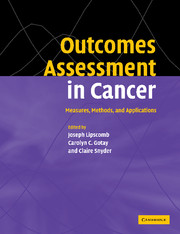Book contents
- Frontmatter
- Contents
- List of contributors
- Acknowledgments
- 1 Introduction to Outcomes Assessment in Cancer
- Health-related quality of life in cancer: general concepts and generic measures
- Assessing health-related quality of life during treatment
- Assessing health-related quality of life across the cancer continuum
- Measuring the experience and needs of cancer patients and caregivers
- Methodological considerations in applications to cancer outcomes research
- 17 Practical considerations in outcomes assessment for clinical trials
- 18 Statistical issues in the application of cancer outcome measures
- 19 The clinical value and meaning of health-related quality-of-life outcomes in oncology
- 20 Cross-cultural use of health-related quality of life assessments in clinical oncology
- Modern psychometric theory in cancer outcomes research
- Assessing the economic impact of cancer
- Research and policy implications
- Invited papers
- Index
- References
20 - Cross-cultural use of health-related quality of life assessments in clinical oncology
Published online by Cambridge University Press: 18 December 2009
- Frontmatter
- Contents
- List of contributors
- Acknowledgments
- 1 Introduction to Outcomes Assessment in Cancer
- Health-related quality of life in cancer: general concepts and generic measures
- Assessing health-related quality of life during treatment
- Assessing health-related quality of life across the cancer continuum
- Measuring the experience and needs of cancer patients and caregivers
- Methodological considerations in applications to cancer outcomes research
- 17 Practical considerations in outcomes assessment for clinical trials
- 18 Statistical issues in the application of cancer outcome measures
- 19 The clinical value and meaning of health-related quality-of-life outcomes in oncology
- 20 Cross-cultural use of health-related quality of life assessments in clinical oncology
- Modern psychometric theory in cancer outcomes research
- Assessing the economic impact of cancer
- Research and policy implications
- Invited papers
- Index
- References
Summary
“Guests are advised to leave their values at the front desk.”
(Notice posted in an Italian hotel lobby)“Language is your most versatile scientific tool. Learn to use it with precision.”
(Anonymous)Introduction
Clinical research in oncology is increasingly characterized by multicenter efforts on an international scale. This has the advantage of improving the efficiency with which clinical trials can be conducted via rapid accrual of patients, and also facilitates the registration of new, effective therapies across national boundaries and health care systems. To carry out such international studies, it is essential that the outcomes of interest are standardized across participating countries. This presents few, if any, problems when focusing on biomedical outcomes such as tumor response or survival. However, when employing treatment outcomes of a more subjective nature, including patients' self-reported symptom experience, perceived health status, and quality of life, cross-cultural issues become of paramount importance. It is essential that the questions we ask and the responses we elicit from our patients maintain the same meaning when translated into different languages and applied in different cultural settings. Without such cross-cultural equivalence, the interpretation of patient-based data in multinational clinical investigations is at best problematic, and at worst impossible.
The past 15 years have witnessed major advances in the development of practical, reliable, and valid questionnaires for assessing the health-related quality of life (HRQOL) of patients with cancer.
- Type
- Chapter
- Information
- Outcomes Assessment in CancerMeasures, Methods and Applications, pp. 406 - 424Publisher: Cambridge University PressPrint publication year: 2004
References
- 3
- Cited by



